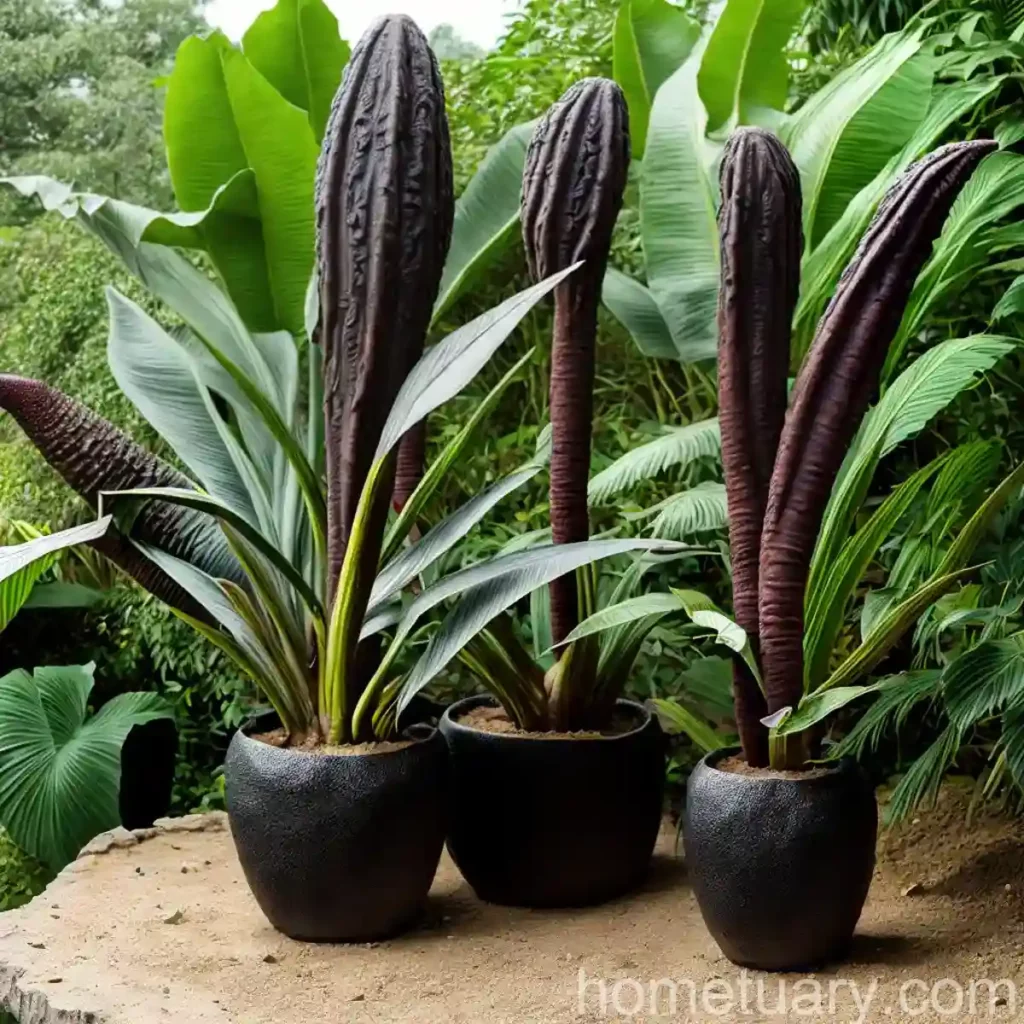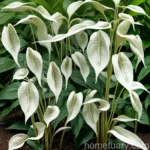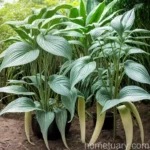Devil’s Tongue (Amorphophallus konjac): A Fascinating, Mysterious, and Hardy Plant
The Devil’s tongue, scientifically known as Amorphophallus konjac, is an extraordinary plant that belongs to the Araceae family. This plant, also referred to as Devil’s Tongue plant, Voodoo lily, Elephant yam, and Konjac root, is native to Southeast Asia, particularly in Japan, China, Indonesia, and Korea. The plant is renowned for its intriguing appearance and various cultural uses. Additionally, it has gained popularity as an ornamental plant and for its unique tuber, which holds significant medicinal and culinary value.
Key Takeaways – Devil’s Tongue (Amorphophallus konjac)
To provide a comprehensive understanding of the Devil’s Tongue plant, this article will delve into its culture, uses, water requirements, sunlight preferences, fertilizer needs, soil conditions, pruning practices, propagation methods, container suitability, popular cultivars, common diseases, pest management, and botanist’s tips. Furthermore, intriguing fun facts about the Devil’s Tongue plant will be explored, and links to external resources will be provided for a deeper exploration into this enigmatic and captivating plant.
What is the Devil’s Tongue (Amorphophallus konjac)?
The Devil’s Tongue plant, scientifically referred to as Amorphophallus konjac, is a perennial, succulent plant characterized by its large, ornamental foliage and impressive flowering structure. This tropical plant is well-known for its resilient nature, adaptability to various environmental conditions, and unique tuberous root, which has been used for centuries in traditional medicine and culinary practices.
Botanical Features of Amorphophallus konjac
- Family: Araceae
- Native Habitat: Southeast Asia (Japan, China, Indonesia, Korea)
- Common Names: Devil’s Tongue plant, Voodoo lily, Elephant yam, Konjac root
- USDA Hardiness Zones: 7-11
- Growth Habit: Herbaceous, clump-forming
- Foliage: Large, palmate leaves
- Flower: Inflorescence with a large spadix and spathe
- Tuber: Edible, starchy root
- Blooming Season: Summer
Amorphophallus konjac is a peculiar and captivating plant that boasts an array of traits that make it both alluring and mysterious. The following sections will provide an in-depth exploration of the cultural aspects, uses, and requirements for cultivating this remarkable plant.
Culture of the Devil’s Tongue (Amorphophallus konjac)
Cultivating the Devil’s Tongue plant requires an understanding of its native habitat, growth habits, and environmental preferences. By emulating the plant’s natural conditions, enthusiasts can encourage robust growth and thriving development of this intriguing plant.
Native Environment
Amorphophallus konjac is indigenous to the tropical and subtropical regions of Southeast Asia, where it thrives in warm, humid climates. This plant is often found in shaded areas of forests and woodlands, where it benefits from the protection of towering trees and rich, organic soils.
Preferred Growing Conditions
To successfully cultivate Devil’s Tongue plants, it is essential to recreate the following growing conditions:
Water
- Moist, well-draining soil
- Regular watering, especially during the growing season
- Avoid waterlogged conditions, as excessive moisture can lead to rot
Sunlight
- Partial shade to dappled sunlight
- Protection from intense midday sun
- Filtered light to replicate the conditions of its native habitat
Soil
- Rich, organic soil with good drainage
- pH: Slightly acidic to slightly alkaline
- Adequate aeration to promote healthy root development
Temperature and Humidity
- Warm temperatures: 65-85°F (18-29°C)
- High humidity: 60-80%
- Protection from cold drafts and frost
Uses of the Devil’s Tongue (Amorphophallus konjac)
The Devil’s Tongue plant has an extensive history of cultural and practical uses, contributing to its significance in various traditions, cuisines, and medical practices.
Culinary Purposes
One of the most well-known uses of Amorphophallus konjac is its edible tuber, which is widely used in Asian cuisine. The gelatinous, starchy root is commonly known as “konjac” and is utilized in the preparation of various culinary dishes, including:
- Konnyaku: A traditional Japanese jelly-like food made from konjac flour
- Shirataki noodles: Translucent, gelatinous noodles made from konjac flour, popular in Japanese cuisine
- Traditional Chinese dishes: Konjac is used in soups, stir-fries, and hot pots
The high fiber content and low-calorie nature of konjac make it a popular ingredient in health-conscious and vegetarian diets. Additionally, konjac is recognized for its ability to absorb and retain flavors, contributing to its versatility in culinary applications.
Medicinal and Health Benefits
In traditional Chinese medicine, the konjac tuber is believed to possess various health benefits, including its potential to aid in digestion, promote weight management, and support cardiovascular health. Moreover, konjac is valued for its rich fiber content, which can contribute to digestive health and regularity.
Cosmetic and Skincare Uses
Konjac root extract is utilized in the production of natural skincare products, particularly in the form of konjac sponges. These sponges, made from konjac powder, offer gentle exfoliation and cleansing properties, making them popular in skincare routines.
Ornamental and Botanical Curiosity
The striking appearance of the Devil’s Tongue plant, characterized by its large, exotic foliage and unique inflorescence, has made it a sought-after ornamental plant in gardens, botanical collections, and indoor settings. Its captivating presence and remarkable flowering structure contribute to its allure as a botanical curiosity.
Watering Devil’s Tongue (Amorphophallus konjac)
Proper Watering Techniques
Amorphophallus konjac thrives in consistently moist but well-draining soil. To maintain optimal soil moisture and support healthy growth, consider the following watering guidelines:
-
Frequency: Water the plant regularly during the growing season, ensuring that the soil remains evenly moist. Avoid allowing the soil to dry out completely.
-
Avoid Waterlogging: While the Devil’s Tongue plant appreciates consistent moisture, it is crucial to prevent waterlogged conditions, as excessive saturation can lead to root rot and detrimental effects on the plant’s health.
-
Misting: In indoor or greenhouse settings, providing regular misting can help create a humid microclimate that mimics the plant’s natural habitat.
Seasonal Considerations
-
Summer: Increase watering frequency during the warmer months, particularly if the plant is situated in a location with heightened temperatures or exposure to direct sunlight.
-
Winter: Reduce watering frequency during the plant’s dormant period, allowing the top layer of soil to dry out slightly between waterings.
Sunlight Preferences for Devil’s Tongue (Amorphophallus konjac)
Ideal Lighting Conditions
In its natural habitat, Amorphophallus konjac thrives in the dappled sunlight and shade of forest understories. When cultivating this plant, it is essential to replicate its preferred lighting conditions to ensure healthy growth and foliage development.
-
Partial Shade: Position the plant in a location that receives filtered sunlight or gentle dappled shade. Protection from direct, intense sunlight is crucial, as excessive exposure can lead to leaf scorch and sun damage.
-
Indoor Settings: When grown indoors, place the Devil’s Tongue plant near a bright, east- or west-facing window. Avoid exposing the plant to direct afternoon sunlight, as it can be too harsh for the plant’s foliage.
Adjusting Light Exposure
If the plant exhibits signs of light stress, such as yellowing or browning of leaves, it is advisable to modify its light exposure by:
-
Shading: Utilize sheer curtains or light-filtering shades to diffuse sunlight and protect the plant from intense rays.
-
Relocation: If grown outdoors, consider moving the plant to a location with increased shade or where it can benefit from the shelter of surrounding trees or structures.
Fertilizing Devil’s Tongue (Amorphophallus konjac)
Nutritional Requirements
Amorphophallus konjac benefits from periodic fertilization, especially during the growing season, to support robust growth and development. Consider the following guidelines for fertilizing Devil’s Tongue plants:
-
Balanced Fertilizer: Utilize a balanced, water-soluble fertilizer with an N-P-K ratio of 10-10-10 or 20-20-20. This will provide essential nutrients for foliage and tuber development.
-
Application Frequency: Apply fertilizer every 4-6 weeks during the active growth period, typically from spring through early fall. Refrain from fertilizing during the plant’s dormant phase.
-
Dilution:
- Outdoor Plants: Dilute the fertilizer to half the recommended strength to avoid over-fertilization and potential root burn.
-
Indoor Plants: Dilute the fertilizer to a quarter of the recommended strength to minimize the risk of fertilizer buildup in the potting medium.
-
Gradual Feeding: Rather than applying a heavy dose of fertilizer at once, adopt a gradual feeding approach to provide a steady supply of nutrients to the plant.
Application Techniques
When applying fertilizer to Devil’s Tongue plants, consider the following techniques to ensure effective nutrient uptake and minimize the risk of fertilizer-related issues:
-
Base of Plant: Apply the diluted fertilizer solution at the base of the plant, allowing it to soak into the soil and reach the root zone.
-
Avoid Foliage: Refrain from applying fertilizer directly to the foliage to prevent leaf burn and potential damage to the plant’s aerial parts.
-
Water After Application: After applying the fertilizer, water the plant to facilitate the distribution of nutrients throughout the soil and promote absorption by the roots.
Soil Requirements for Devil’s Tongue (Amorphophallus konjac)
Ideal Growing Medium
Amorphophallus konjac thrives in a rich, well-draining growing medium that provides a conducive environment for healthy root development and plant vigor. When selecting or preparing the soil for the Devil’s Tongue plant, consider the following soil requirements:
-
Organic Content: Choose a potting mix or garden soil that contains ample organic matter, such as compost, leaf mold, or well-rotted manure. This will enhance soil fertility and moisture retention.
-
Drainage: Ensure that the soil mix offers excellent drainage to prevent waterlogging and promote aeration around the plant’s roots.
-
Aeration: Incorporate materials such as perlite or coarse sand to improve soil aeration and prevent compaction.
-
pH Level: Aim for a slightly acidic to slightly alkaline pH range of 6.0-7.5 to accommodate the plant’s preferences.
Sourcing Suitable Soil
When cultivating Devil’s Tongue plants in containers or garden beds, consider the following options for sourcing or preparing the ideal soil mix:
-
Commercial Potting Mix: Select a high-quality potting mix formulated for tropical plants or foliage-loving species. These mixes often contain the necessary components for optimal growth.
-
Homemade Blend: Create a custom soil blend by combining equal parts of peat moss, compost, and perlite to ensure a balanced, nutrient-rich growing medium.
-
Amending Garden Soil: If planting in the ground, amend existing garden soil with organic matter to improve its structure and fertility, ensuring that it meets the plant’s requirements.
Pruning Practices for Devil’s Tongue (Amorphophallus konjac)
Maintenance and Aesthetic Pruning
Amorphophallus konjac generally requires minimal pruning, as the plant’s unique foliage and inflorescence serve as captivating features without the need for extensive grooming. However, the following pruning practices can contribute to the plant’s health and appearance:
-
Removal of Damaged Foliage: Trim or remove any damaged, yellowing, or diseased leaves to maintain a tidy and healthy appearance.
-
Deadheading: After the flowering period, trim away spent blossoms and withered portions of the inflorescence to tidy up the plant and encourage new growth.
-
Pruning Restrictions: Avoid extensive pruning of healthy foliage and flowering structures, as the plant’s growth is primarily centered on its large, ornamental leaves and distinctive inflorescence.
Tuber Maintenance
-
Harvesting: In regions where Amorphophallus konjac is cultivated for its edible tubers, harvesting can be performed when the tubers reach maturity. Carefully dig around the base of the plant to retrieve the tubers without causing damage to the plant.
-
Storage: After harvesting, the tubers can be stored in a cool, dry location to preserve them for culinary use. Ensure proper ventilation and periodic inspection to prevent spoilage.
Propagation Methods for Devil’s Tongue (Amorphophallus konjac)
Division
One of the primary methods of propagating Amorphophallus konjac is through the division of the plant’s rhizomes or tuber offsets. This process typically occurs during the dormant season or when the plant is being repotted, and it involves the following steps:
-
Rhizome Separation: Carefully lift the plant from its growing medium and identify healthy rhizomes or tuber offsets that can be separated from the parent plant.
-
Sectioning: Using a clean, sharp knife, divide the rhizomes or tuber offsets into sections, ensuring that each section possesses viable buds or growth points.
-
Potted Propagation: Plant the divided rhizome sections or tuber offsets in individual containers filled with well-draining soil, positioning them at a suitable depth and providing proper moisture and light conditions for new growth.
Seed Propagation
While less commonly employed due to the time-consuming nature of the process, Amorphophallus konjac can be propagated from seeds, particularly for the purpose of cultivating and introducing new varieties. Seed propagation involves the following steps:
-
Seed Collection: Harvest mature seeds from the plant’s pollinated inflorescence, allowing them to fully ripen and develop before collection.
-
Sowing: Plant the seeds in a suitable germination medium, such as a well-draining, nutrient-rich soil mix, and maintain consistent moisture and warmth to facilitate germination.
-
Seedling Care: Provide attentive care to the emerging seedlings, ensuring proper light, water, and nutrition to support their early growth.
-
Transplanting: Once the seedlings have developed and reached a suitable size, transplant them into individual containers or prepared garden beds to continue their growth and eventual maturity.
Container Cultivation of Devil’s Tongue (Amorphophallus konjac)
Container Selection
When cultivating Amorphophallus konjac in containers, it is crucial to choose appropriate pots that accommodate the plant’s growth habits and provide favorable conditions for its development:
-
Size: Select a spacious container that offers ample room for the plant’s rhizomes and root system to expand. A depth of at least 12-18 inches is desirable to accommodate the tuber’s growth.
-
Drainage Holes: Ensure that the container has sufficient drainage holes to prevent waterlogging and facilitate the release of excess moisture from the soil.
-
Material: Opt for durable, non-porous materials such as ceramic, plastic, or glazed clay, as the tuberous nature of Amorphophallus konjac necessitates a degree of moisture retention and protection from rapid evaporation.
Potting Mix and Planting
When planting Devil’s Tongue in containers, it is essential to employ a suitable potting mix and follow proper planting techniques to establish healthy growth:
-
Potting Medium: Utilize a well-draining, nutrient-rich potting mix with a balanced combination of organic matter, perlite, and coarse sand to encourage optimal root development and moisture regulation.
-
Planting Depth: Position the tuber in the container at a depth that allows the top of the tuber to be approximately 1-2 inches below the soil surface, ensuring the proper establishment of the plant.
-
Container Placement: Select a location that provides the Devil’s Tongue plant with filtered sunlight or partial shade, protecting it from intense direct sunlight while maintaining favorable light exposure for growth.
Indoor Considerations
-
Humidity Enhancement: In indoor settings, consider supplemental methods to increase humidity around the plant, such as using a humidity tray or misting the foliage regularly to mimic the plant’s native environment.
-
Ventilation: Ensure proper air circulation around indoor plants to prevent stagnant conditions and minimize the risk of fungal issues or pest infestations.
Popularity of Devil’s Tongue (Amorphophallus konjac) Cultivars
Notable Cultivars and Varieties
Amorphophallus konjac encompasses a range of cultivars and varieties that exhibit diverse leaf morphology, coloration, and inflorescence characteristics. Some of the popular and distinctive cultivars include:
‘Sangria’
- Features: Striking purple-hued petioles and vibrant green leaf blades
- Inflorescence: Exhibits a distinctively colored spathe and spadix
‘Purpureospatha’
- Characteristics: Foliage with variegated patterns of deep green and purple, creating a visually captivating display
- Inflorescence: Notable for its contrasting hues and intricate patterning
‘Green Dragon’
- Foliage: Displaying a dynamic blend of green shades and intricate leaf vein patterns
- Inflorescence: Showcases a visually appealing spathe and spadix composition
Growing Demand and Enthusiastic Adoption
The unique and captivating nature of Amorphophallus konjac cultivars has contributed to an increasing demand and enthusiastic adoption by plant enthusiasts, collectors, and botanical gardens. Gardeners are captivated by the striking foliage and fascinating floral displays offered by these distinct cultivars, adding intriguing diversity to ornamental plant collections and horticultural displays.
Common Diseases Affecting Devil’s Tongue (Amorphophallus konjac)
Fungal Issues
Amorphophallus konjac can be susceptible to fungal diseases under conditions of high humidity, poor air circulation, or overly moist soil. Common fungal diseases that may affect the plant include:
-
Powdery Mildew: Manifests as a powdery white coating on the plant’s foliage, leading to diminished vigor and aesthetic decline.
-
Leaf Spot: Presents as dark, water-soaked lesions on the leaves, potentially leading to defoliation and reduced photosynthetic capacity.
Prevention and Management
To mitigate the risk of fungal issues and maintain the health of Devil’s Tongue plants, implement the following preventive and management measures:
-
Air Circulation: Enhance air movement around the plant through proper spacing, strategic placement, or the use of fans in indoor settings.
-
Avoid Overhead Watering: Minimize splashing of water onto the foliage and ensure that the plant’s leaves remain dry to discourage the development of fungal pathogens.
-
Sanitation: Regularly remove fallen or diseased foliage, debris, or plant residues to reduce the likelihood of fungal spores proliferating and spreading.
Cultivar-Specific Considerations
Some cultivars of Amorphophallus konjac may exhibit varying degrees of resistance or susceptibility to fungal diseases. When selecting and cultivating specific cultivars, consider any known attributes related to















